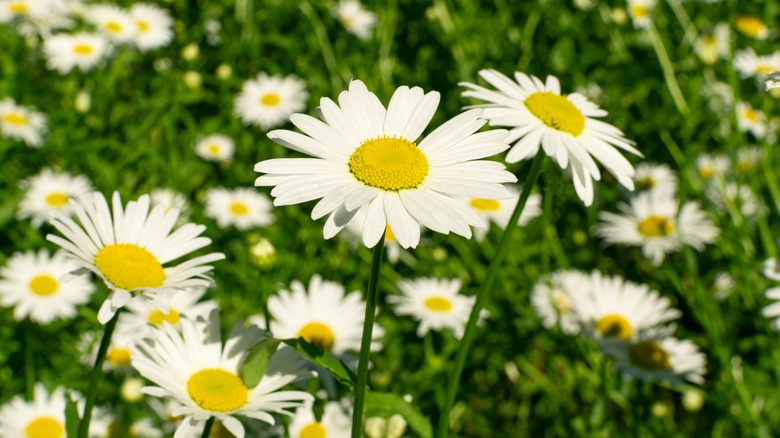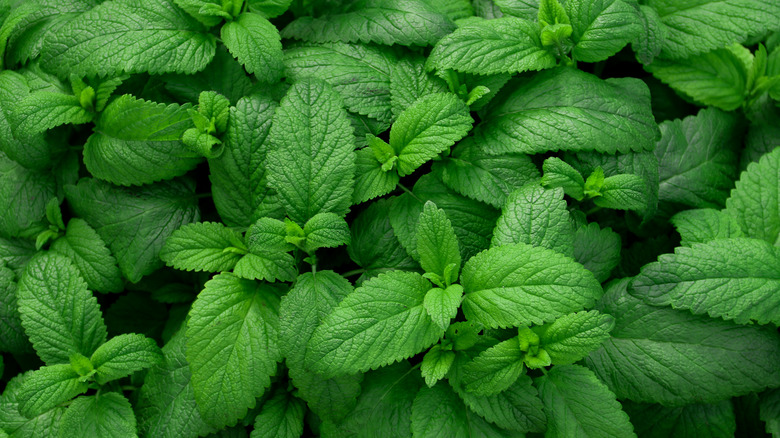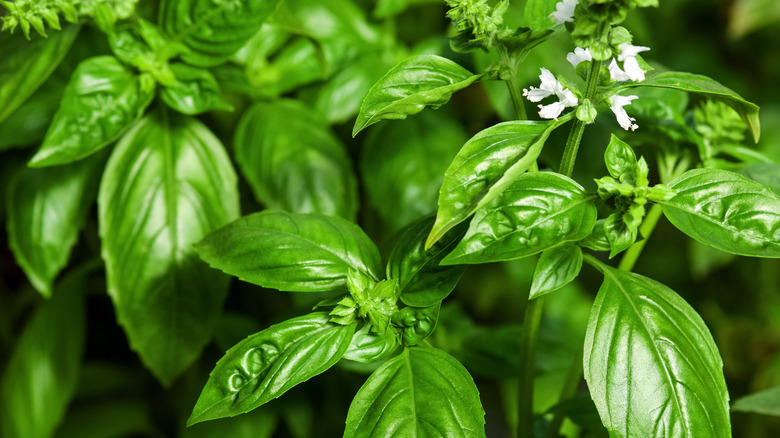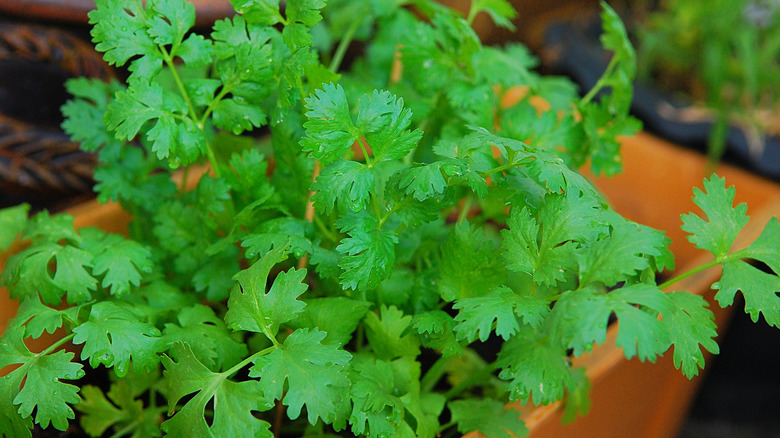15 Herbs Perfect For Growing In Your Backyard Garden
Herb plants are known to be one of the easiest types of plants to grow in the garden for beginners. Most herbs can tolerate a range of growing conditions as long as they are planted in a spot that receives plenty of sunlight. The best part about growing plants like parsley, rosemary, and thyme is that you receive flavorful ingredients to use in the kitchen in no time, depending on the method you use. No matter what size plot of land you have to work with, you can grow many of these herbs without buying much more than garden soil, seeds, and a shovel.
If you're tired of cooking with flavorless dried herbs or spending money on expensive fresh oregano, dill, and basil, try your hand at this sustainable practice. When you cultivate your own herbs, you can control their freshness and how they are grown. As pointed out by the University of Missouri Extension, the conditions you provide your edible plants will affect the taste of your harvest. Check out this collection of 15 herbs, and remember to consider their growth requirements before buying so you can enjoy the best flavors your garden offers.
1. German chamomile
German chamomile (Matricaria recutita), native to Europe and western Asia, is commonly used in cooking, cosmetics, potpourris, and medicine. Like other garden herbs, this plant should be introduced to the outdoors just after the last frost. After growing German chamomile in your garden once, you may see it come back yearly as it is a prolific self-seeder, as per Missouri Botanical Garden.
Bloom Season: Summer
USDA Growing Zone: 2 to 8
Growing Conditions: Full sun
Soil Type: Well-draining
Size: 12 to 24 inches tall and 9 to 12 inches wide
2. Parsley
Parsley (Petroselinum crispum) is a popular herbaceous biennial that can be grown from a seed or a young plant in your backyard garden. The plant features curly leaves that smell pungent and taste delicious when used in a variety of dishes. Parsley is relatively easy to grow. According to the University of Wisconsin-Madison Division of Extension, it should be planted in rich soil where it receives plenty of sunlight.
Bloom Season: Summer
USDA Growing Zone: 3 to 9
Growing Conditions: Full sun
Soil Type: Rich and well-draining
Size: 12 to 18 inches tall
3. Lemongrass
Lemongrass (Cymbopogon citratus) is most often grown in warmer states and countries that experience hot and humid weather conditions. It has beautiful, fragrant herbage that can be harvested or left to grow for its visual appeal, as described by Proven Winners. The plant's thin leaves can be used in medical or culinary practices when cut.
Bloom Season: Spring, summer, and fall
USDA Growing Zone: 9 to 11
Growing Conditions: Full sun to partial shade
Soil Type: Well-draining
Size: 2 to 4 feet tall and 8 to 12 inches wide
4. Mint
Mint plants (Mentha spp.) are widely used in teas, desserts, meat dishes, and pasta dishes. As explained by Utah State University Extension, several varieties of mint have slightly different flavors that make them more suitable for use in certain concoctions. Still, each of these cultivars shares similar growing requirements that make them easy to grow together in the garden.
Bloom Season: Summer to fall
USDA Growing Zone: 3 to 8
Growing Conditions: Full sun to partial shade
Soil Type: Moist, rich, and slightly organic
Size: Up to 3 feet tall
5. Lavender
Lavender plants (Lavandula angustifolia) aren't always used in the kitchen like other herbs, but they are just as valuable to grow in your backyard garden. As mentioned by Missouri Botanical Garden, lavender attracts pollinators, gives your outdoor space a relaxing aroma, and adds visual interest to leafier herbs. Plant your lavender bushes in full sun and well-drained soil for the best results.
Bloom Season: Summer
USDA Growing Zone: 5 to 8
Growing Conditions: Full sun
Soil Type: Low fertility, alkaline, and well-draining
Size: 3 feet tall and 4 feet wide
6. Rosemary
Rosemary (Salvia rosmarinus) is another shrub with a bushy shape that can be grown ornamentally or for its scented, flavorful leaves. This plant, which blooms with white, purple, or blue flowers, is quite simple to grow because it is not fussy about the soil it is planted in nor the season in which you harvest it, according to The Royal Horticultural Society.
Bloom Season: Spring and summer
USDA Growing Zone: 8 to 10
Growing Conditions: Full sun
Soil Type: Moist, well-draining chalk, loam, clay, or sand
Size: Up to 8 feet tall and wide
7. Thyme
Thyme (Thymus vulgaris) is among the most common herb garden plants. Like many of the fragrant, herbaceous plants we've already covered, thyme is easy to grow and has various uses within the home. As pointed out by the North Carolina Extension Gardener Plant Toolbox, thyme should be pruned regularly to eliminate leggy growth, and it is best to harvest just before it flowers at the end of spring.
Bloom Season: Spring and summer
USDA Growing Zone: 5 to 9
Growing Conditions: Full sun
Soil Type: Evenly moist and well-draining
Size: 6 to 12 inches tall and wide
8. Basil
The basil plant (Ocimum basilicum), native to the tropical regions of Asia and Africa, doesn't withstand cold weather like other herbs, and it is very susceptible to frost damage. This annual can be identified by its glossy, ovate leaves and its fragrant aroma released from its foliage and flowers, notes Missouri Botanical Garden.
Bloom Season: Summer to fall
USDA Growing Zone: 2 to 11
Growing Conditions: Full sun
Soil Type: Rich and well-draining
Size: Up to 2 feet tall and wide
9. Cilantro
Cilantro and coriander (Coriandrum sativum) come from the same herbaceous plant that produces edible stems and flowers. The cilantro plant is tolerant of shade and cooler weather, so that it can provide you with tasty leaves and seeds longer than some other herbs. Even if you are not a fan of the taste of cilantro, this plant can be valuable in a pollinator garden, as per the North Carolina Extension Gardener Plant Toolbox.
Bloom Season: Summer
USDA Growing Zone: 2 to 11
Growing Conditions: Full sun to partial shade
Soil Type: Well-draining loam
Size: 1 to 2 feet tall and wide
10. Sage
Sage (Salvia officinalis) is not only recommended for backyard herb gardens but also coastal gardens, courtyard gardens, wall side borders, and container plantings, says The Royal Horticultural Society. This versatile shrub can tolerate a few different lighting conditions, soils, and watering schedules. However, it should be mentioned that sage can be susceptible to powdery mildew, root rot, and verticillium wilt.
Bloom Season: Summer
USDA Growing Zone: 6 to 10
Growing Conditions: Full sun
Soil Type: Well-draining
Size: 16 inches tall and 24 inches wide
11. Oregano
Oregano (Origanum vulgare) is a deciduous shrub in the Lamiaceae family that includes mint, sage, basil, thyme, rosemary, and many other culinary herbs. Also referred to as marjoram, this drought-tolerant shrub has a low spreading growth habit that makes it great for herb gardens and raised garden beds. It can also be used as a ground cover plant, as WSU Clark County Extension suggested.
Bloom Season: Summer
USDA Growing Zone: 3 to 9
Growing Conditions: Full to partial sun
Soil Type: Well-draining
Size: 2 feet tall and wide
12. Dill
Dill (Anethum graveolens), as described by the University of Wisconsin-Madison Division of Extension, is an annual plant in the parsley family. It is native to regions of Europe, Russia, and Asia, as it thrives in areas that provide hot, dry summer weather. There are a few distinct cultivars of the dill plant. Most are good for culinary use, but some are more often used in flower arrangements, such as the 'Vierling' variety.
Bloom Season: Summer
USDA Growing Zone: 2 to 11
Growing Conditions: Full sun
Soil Type: Rich and well-draining
Size: 18 inches to 4 feet tall
13. Chives
Chives (Allium schoenoprasum), closely related to onion and garlic, are grown for their savory leaves and purple flowers that appear in the summer. The Royal Horticultural Society points out that this garden herb is easy to grow. It can be planted in a few different kinds of soil, and it does not need full sun to provide you with its delicious foliage.
Bloom Season: Summer
USDA Growing Zone: 4 to 8
Growing Conditions: Full sun to partial shade
Soil Type: Evenly moist and well-draining
Size: 4 to 20 inches tall and 4 inches wide
14. Lemon verbena
Lemon verbena (Aloysia citriodora), also called lemon beebrush, is a warm-weather herb native to northwestern Argentina and Bolivia. In these countries and many others around the world, lemon verbena is used to flavor teas, jams, and desserts. As told by the North Carolina Extension Gardener Plant Toolbox, the plant has recently found use in cosmetics and perfumes.
Bloom Season: Fall to summer
USDA Growing Zone: 8 to 10
Growing Conditions: Full sun
Soil Type: Well-draining loam
Size: 2 to 4 feet tall and wide
15. Fennel
Fennel (Foeniculum vulgare), which looks like dill in the garden, can be identified from its leaves and stems, which are slightly longer and thicker than dill leaves. The easiest way to tell them apart, however, is by taste, and fennel has an intense licorice flavor while dill tastes much grassier. The University of Wisconsin-Madison Division of Extension says that the fennel plant can be grown for culinary and ornamental use.
Bloom Season: Summer
USDA Growing Zone: 4 to 9
Growing Conditions: Full sun
Soil Type: Well-draining
Size: Up to 6 feet tall















